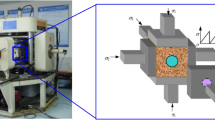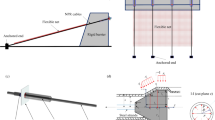Abstract
In this paper, our analysis concentrated on the mechanical behavior of sandwich panel subjected to impact loading. Thus, to improve the resistance of satellite structures from debris collision consequences; we proceed a performance investigation numerically of different materials based on the evaluation of contact force, total energy and kinetic energy generated from the impact of spherical steel debris on sandwich panel. Furthermore, a comparison of deformations and stresses levels in sandwich panel collide by a projectile at hyper-high velocity using finite element with ANSYS code was made. The difference between our models is the type of skins materials which are aluminum and functionally graded material FGM (alumina/nickel). The impact results a total perforation of sandwich panel with aluminum facesheets creating a fragments; contrary to FGM which the projectile penetrates only the front facesheet and honeycomb core. However, for an effective protection of sandwich panel against debris perforation, the introduction of FGM skins technique is considered as a candidate solution.



























Similar content being viewed by others
References
Sibeaud JM, Thamie L, Puillet C (2008) Hypervelocity impact on honeycomb target structures: experiments and modeling. Int J Impact Eng 35:1799–1807
Iliescu LE, Lakis AA, Oulmane A (2016) Satellites-spacecraft materials and hypervelocity impact testing numerical simulations. Eur J Mech Eng Res 3(3):41–77
Schonberg W, Schafer F, Putzar R (2010) Hypervelocity impact response of honeycomb sandwich panels. Acta Astronaut 66:455–466
Kang P, Youn SK, Lim JH (2013) Modification of the critical projectile diameter of honeycomb sandwich panel considering the channeling effect in hyper velocity impact. Aerosp Sci Technol 29:413–425
Maiden J, McMillan AR (1964) An investigation of the protection afforded a spacecraft by a thin shield. AIAA J 2(11):1992–1998
Liu P, Liu Y, Zhang X (2014) Internal-structure-model based simulation research of shielding properties of honeycomb sandwich panel subjected to high-velocity impact. Int J Impact Eng 77:120–133. https://doi.org/10.1016/j.ijimpeng.2014.11.004
Higashide M, Nagao Y, Kibe S et al (2010) Debris impact on CFRP-AL honeycomb sandwich structure. Aerosp Technol Jpn 8:Pr_2_1–Pr_2_5
Guangyong S, Dongdong C, Hongxu W et al (2018) High-velocity impact behaviour of aluminum honeycomb sandwich panels with different structural configurations. Int J Impact Eng 122:119–136. https://doi.org/10.1016/j.ijimpeng.2018.08.007
Kolopp A, Alvarado R, Rivallant S, Bouvet C (2013) Modeling impact on Aluminum sandwich including velocity effects in honeycomb core. J Sandw Struct Mater 13(6):733–757. https://doi.org/10.1177/1099636213501102
Arslan K, Gunes R (2018) Experimental damage evaluation of honeycomb sandwich structures with Al/B4C FGM face plates under high velocity impact loads. Compos Struct 202:304–312. https://doi.org/10.1016/j.compstruct.2018.01.087
Wahl L, Maas S, Waldmann D et al (2014) Fatigue in the core of aluminum honeycomb panels: lifetime prediction compared with fatigue tests. Int J Damage Mech 23:661–683
Zhang J, Ashby M (1992) the out-of-plane properties of honeycombs. Int J Mech Sci 34:475–489
Mohammed DF, Ameen HA, Mashloosh KM (2015) Experimental and numerical analysis of AA3003 honeycomb sandwich panel with different configurations. Am J Sci Ind Res 6(2):25–32
Johnson GR, Cook WH (1983) A constitutive model and data for metals subjected to large strains, high strain rates and high temperatures. In: Proceedings of the 7th international symposium on ballistics, The Hague, The Netherlands
Brar NS, Joshi VS, Harris BW (2009) Constitutive model constants for Al7075T651 and Al7075-T6. In: AIP conference proceedings, vol 1195, pp 945–948
Johnson GR, Cook WH (1985) Fracture characteristics of three metals subjected to various strains, strains rates temperatures and pressures. Eng Fract Mech 21(1):31–48
Wang Q, Quek ST, Liu X (2001) Analysis of piezoelectric coupled circular plate. Smart Mater Struct 10:229–239
Reddy JN, Praveen GN (1998) Nonlinear transient thermoelastic analysis of functionally graded ceramic-metal plate. Int J Solids Struct 35:4457–4476
Touloukian YS (1967) Thermo-physical properties of high temperature solid materials. McMillan, New York
Reddy JN, Chin CD (1998) Thermomechanical analysis of functionally graded cylinders and plates. J Therm Stress 21:593–626
Williamson RL, Rabin BH, Byerly GE (1995) FEM study of the effects of interlayers and creep in reducing residual stresses and strains in ceramic-metal joints. Compos Eng 5:851–863
Williamson RL, Rabin BH, Drake JT (1993) Finite element analysis of thermal residual stresses at graded ceramic-metal interfaces, part I: model description and geometrical effects. J Appl Phys 74(2):1310–1320
Drake JT, Williamson RL, Rabin BH (1993) Finite element analysis of thermal residual stresses at graded ceramic-metal interfaces, part II: inter-face optimization for residual stress reduction. J Appl Phys 74(2):1321–1326
Giannakopoulos AE, Suresh S, Finot M et al (1995) Elastoplastic analysis of thermal cycling: layered materials with compositional gradients. Acta Metall Mater 43(4):1335–1354
Finot M, Suresh S, Bull C, Sampath S (1996) Curvature changes during thermal cycling of a compositionally graded Ni–Al2O3 multi-layered material. Mater Sci Eng A-205:59–71
Cho JR, Choi JH (2004) A yield-criteria tailoring of the volume fraction in metal ceramic functionally graded material. Eur J Mech A Solids 23:271–281
Tamura I, Tomota Y, Ozawa H (1973) Strength and ductility of FeNiC alloys composed of austenite and martensite with various strength. In: Proceedings of the third international conference on strength of metals and alloys, vol 1, pp 611–615
Fischmeister H, Karlsson B (1977) Plasticity of two-phase materials with a coarse microstructure. Z Metallkunde 68:311–327
Xie WH, Meng SH, Ding L et al (2018) High-temperature high-velocity impact on honeycomb sandwich panels. Compos B 138:1–11. https://doi.org/10.1016/j.compositesb.2017.06.022
Author information
Authors and Affiliations
Corresponding author
Additional information
Technical Editor: André Cavalieri.
Publisher's Note
Springer Nature remains neutral with regard to jurisdictional claims in published maps and institutional affiliations.
Appendix
Appendix
APDL Subroutine for the determination of FGM facesheet volume fraction distribution using power law.

Rights and permissions
About this article
Cite this article
Smahat, A., Mankour, A., Slimane, S. et al. Numerical investigation of debris impact on spacecraft structure at hyper-high velocity. J Braz. Soc. Mech. Sci. Eng. 42, 117 (2020). https://doi.org/10.1007/s40430-020-2196-7
Received:
Accepted:
Published:
DOI: https://doi.org/10.1007/s40430-020-2196-7




